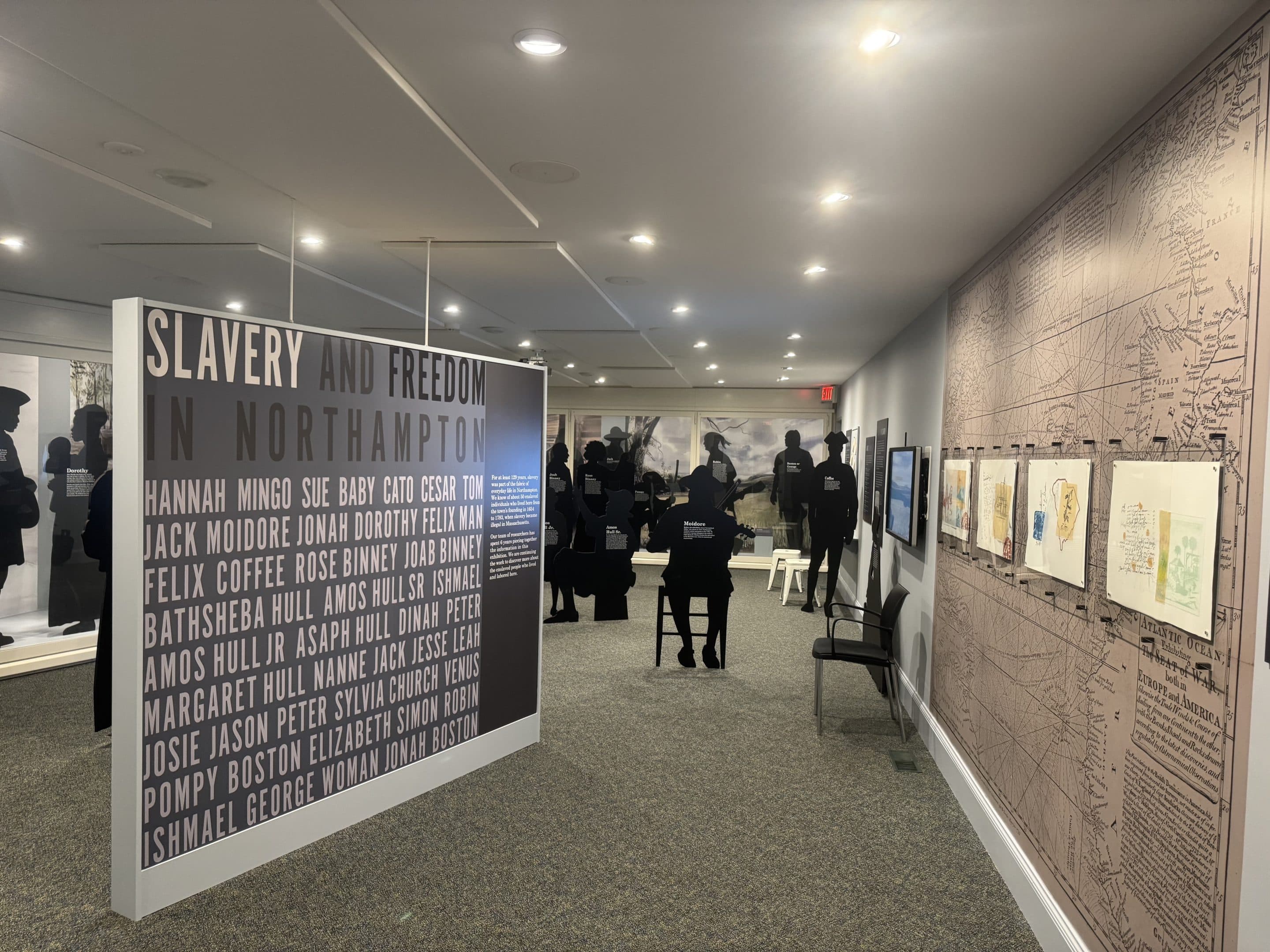The new “Slavery and Freedom in Northampton” exhibit is now on display inside of Historic Northampton.
Reminder Publishing photos by Trent Levakis.
NORTHAMPTON — A new exhibit at Historic Northampton is highlighting the city’s history as it relates to slavery in “Slavery and Freedom in Northampton, 1654 to 1783.”
The exhibit explores how for at least 129 years, slavery was part of the fabric of everyday life in Northampton, as at least 50 enslaved individuals lived in the city from the town’s English settlement in 1654 until 1783 when slavery was abolished in Massachusetts.
The exhibit was designed by Michael Hanke of Design Division, Inc., with Historic Northampton and a team of scholars and archivists based upon research by the Northampton Slavery Project.
Historic Northampton Museum Educator Elizabeth Sacktor told Reminder Publishing the work behind this project has been six years in the making, following the formation of the Northampton Slavery Research Project in collaboration with Forbes Library.
“That was basically just sort of putting together and trying to figure out what do we know about the enslaved population in Northampton,” said Sacktor.
As Historic Northampton posted this research project findings on their website for the public to see, they found that people were not utilizing the website, and the great work uncovered was largely going unnoticed. So, brainstorming led the team at Historic Northampton to start a collaborative effort in bringing an in-person experience to showcase the work from the Northampton Slavery Project.
“We wanted to take the information that we gathered over the last six years and create some sort of accessible experience that’s in person for people,” said Sacktor.
The exhibit features graphic silhouettes of men, women and children who were enslaved. On each graphic silhouette are details about individual lives based upon information gleaned from historic documents. Their histories reveal aspects of enslavement and examples of freedom, and resistance to oppression.
The exhibit opened on July 3 and will be available to the public Wednesdays through Sundays, 11 a.m. to 5 p.m., until Dec. 11, 2026. Admission is by donation.
The exhibit tells what is currently known about the lives of these enslaved individuals and how some gained freedom, started families and purchased property. It also describes the ways in which Northampton enslavers exerted power and control over their lives.
The decision to create this exhibit was made in fall 2024 and the process of putting it together has been largely collaborative between researchers, members of the Historic Northampton board, Forbes Library local history specialist Dylan Gaffney, local educators and members of the Northampton Reparations Study Commission.
Gaffney, from Forbes Library, was a main source for many of the documents featured in the exhibit that helped show who some of these enslaved individuals were and what life was like for them as they lived in Northampton. Other documents were archived from the Hampshire County Probate Records.
“There were a lot of people involved. Basically, we got this big group together and we started sort of brainstorming what would this look like. All of us on the team wanted this to be an individual — kind of personal — experience to encounter each of these people because it’s so easy to think about the history of slavery as kind of a generalized experience and it’s also really easy to think about ‘we don’t know that much about these people because we have such limited documentation,’ and that’s actually not true,” said Sacktor.
She continued, “We really wanted people to be able to encounter these people as individuals because we wanted them to have that humanizing experience. When they were alive, their humanity was taken from them by the system of white supremacy that was perpetuated by the government and community of Northampton, so we wanted to be able to give that community back to them and by portraying them as individuals with stories, lives, desires, motivations and relationships, we were able to do that.”
Some of the displays around the exhibit have different individuals set up with backdrops of what would have been their work or home life settings and others are grouped as families or partners throughout the exhibit space. There is also an interactive touch screen timeline containing all the same information featured throughout the exhibit for another form of taking in this history.
Sacktor added, historicnorthampton.org contains all the Northampton Slavery Project findings and more information about this new exhibit, making it a good companion to the exhibit.
There is also a section of the exhibit that helps break down a broader understanding of Northampton’s role in slavery. While Massachusetts abolished slavery in 1783, businesses in the city still had economic ties to slavery as one company sold gardening tools specifically for use on plantations and another continued production of straw hats and other items that would be delivered to plantations in the south.
“Because of a lot of the focus around cotton, rice and production of single cash crops in the south, it meant that they didn’t have the excess labor to be supporting all their secondary needs, so a lot of those secondary needs are being supplied by the north and a community like Northampton,” said Sacktor. “They’re all ways that Northampton is partaking in slavery as a system of exploitation and labor and commerce after they claimed to have not been involved in it.”
The exhibit also includes a printmaking series, “Glimmers of Past People,” by artist Merisa Skinner, reflecting on the local legacy of the transatlantic slave trade. Skinner was involved in all the committee meetings on the exhibit as well.
“She was here for the development of the exhibit and so she got to see all the sources and that really inspired this work here that she did because it’s very much inspired by the kind of act of looking at sources layered on top of each other and trying to put together a picture of what that means in your mind,” said Sacktor.
The map in the background of the printmaking work is a 1755 map that was uncovered that displays different trade routes across the Atlantic Ocean, including slave trading routes, as well as wind information and navigational directions.
Sacktor said she hopes people who come see the exhibit leave knowing about some of the individuals and their life stories, and that is gives them added perspective for the city’s history in part of American history.
“They were human beings and despite what a lot of public scholars will tell you, we actually do know a lot more about them then you would think,” said Sacktor.
Sacktor added she was really proud of the collaborative work done on this exhibit and hopes it can serve as an example for other communities interested in digging into their own history.
“I think we’re really lucky that we’re in a community that is as supportive of an exhibit like this as we are. We didn’t get any grants for this exhibit, this was entirely funded by the community itself which I think just says a lot about the amazing supporters and the amazing community of Historic Northampton, but also just that the community of Northampton wants to talk about this history and they are interested in it. And as much as there is sometimes pushback and it makes people uncomfortable, I think sometimes it’s a good thing. I think sometimes it’s OK to be a little bit uncomfortable. I’m really grateful that the community of Northampton is as supportive of putting their money where their mouth is when it comes to prioritizing this kind of history. It can only happen when you have that kind of community support.”



